
|
|
back
MENU
|
|
Private
|

Derating
Weibull survivor function
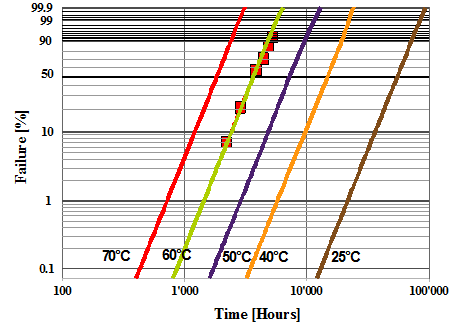
Failure mode = cell opening
Survivor = cell not opened
Voltage = 2.7 V
Temperature = 60C (green curve)
Extrapolation to
70C (red)
50C (blue)
40C (Orange)
RT (brown)

λo = 3900 hours
p = 5
Red square: measurment performed on a batch of 14 supercapacitors with a weak pressure release device. The failure of 1 piece represents the loss of 7,1% of the tested population.
Coefficient p and λo
The coefficient λo and p must be determined.
for all the failure modes
for all the operating temperature
for all the operating voltage
It is done experimentally for
Several temperature ( 40C, 50C, 65C, 70C, -.)
Several voltage (2.3 Vdc, 2.5 Vdc, 2.7 Vdc, 2.9 Vdc,
The coefficient p and λo for the other temperatures and voltages are calculated with the derating laws presented below.
Lifetime temperature derating
Failure mode = 20% capacitance loss

Temperature derating
factor in the Arrhenius law: Ea /k = 12800 [K] which corresponds to
an activation energy of 1.1 eV.
Arrhenius law
where
t(T) is the lifetime at the temperature T,
tn is the lifetime at the reference temperature of 65 C,
Ea is the activation energy determined by the experimental data.
k is the Boltzmann constant (1.38 1023)
Tn = 338 K is the reference temperature (65 C).
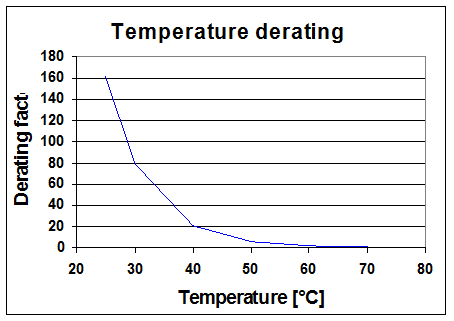
Inverse power voltage derating
Failure mode = 20% capacitance loss

Inverse power law
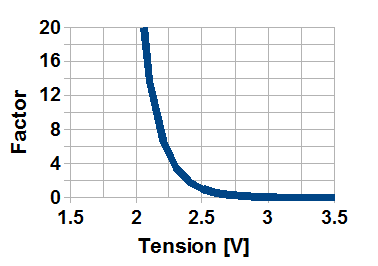
where
t(V) is the capacitor lifetime with the voltage V and the reference temperature of 65 C,
tvn is the capacitor lifetime for the reference voltage of Vn and 65 C,
N is a constant determined experimentally (15 in our example),
Vn is the reference voltage (2.5 Vdc in our example).
Exponential voltage derating

where
t(V) is the capacitor lifetime with the voltage V and the reference temperature of 65 C,
tvn is the capacitor lifetime for the reference voltage of Vn and 65 C,
a is a constant determined experimentally (15 in our example),
Vn is the reference voltage (2.5 Vdc in our example).
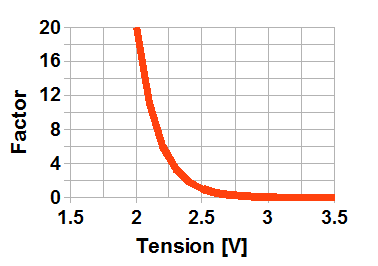
Derating calculation

t1 is the lifetime at the temperature T1 and voltage V1
t2 is the lifetime at the temperature T2 and voltage T2
Ea is the activation energy determined by the experimental data
k is the Boltzmann constant
N is a constant determined experimentally.
Calculation method
The supercapacitor lifetime is determined by the failure mode which has the shortest lifetime expectancy.
(typicaly 20% capacitance loss are reached earlier than 100% of ESR increase)
From the theoretical λo and p obtained with the derating factors and based on the experimental data measured at 2.5 Vdc and 65C, we calculate for each temperature and each voltage the statistical time to loose 1 o/oo (F(t)=0.999) of the supercapacitor of a batch.
Theoretical lifetime expectation
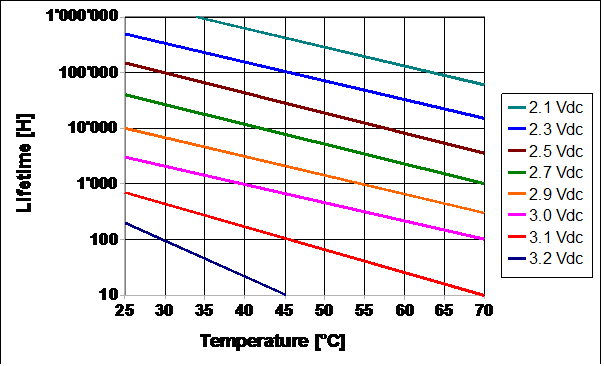
Tool for lifetime expectation calculation
Addition of all the stress ponderated contribution L(V,T) is the lifetime of the contribution at V and T.
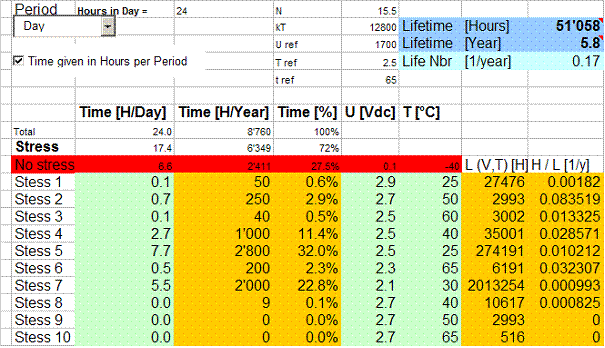
20% capacitance drop time statistic
The capacitance drop evolution must not be confused with the statistical time distribution to reach the capacitance loss of a given amount of 20% of an ultracapacitor batch.
A rough estimation shows that the time gap between the first sample and the last sample to reach the limit is about 10 % of the time to fail. In the chart the end of life is reached between 2000 and 2200 hours for a test run on 4 samples at 65C and 2.5 Vdc.
Supposing that this failure statistic is following Weibull model, the parameters will be recovered in the following way:
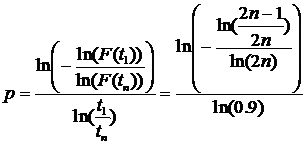
Where tn is the time to fail for the last piece of a batch of n samples and t1 the time to fail for the first one. 1/λo corresponds to the time when 36.8% (= 1/e) of survivors are remaining, or in other words, when 63.2% (= 1 1/e) of the samples have failed.
In the case of a dispersion of 10%, the accuracy is sufficient to approximate the lifetime with

The numerical calculation shows that p = 26.
Acceleration factors based on Rp
All measurements were performed on one and the same BCAP0350 cell. After equilibrating the cell at the respective potential, the leakage current was measured 10 h after a temperature step. The logarithm of the leakage current is plotted versus the reciprocal of the temperature in K. From this type of Arrhenius plot, one could determine the activation energy of the degradation processes, provided the plots result in straight lines.
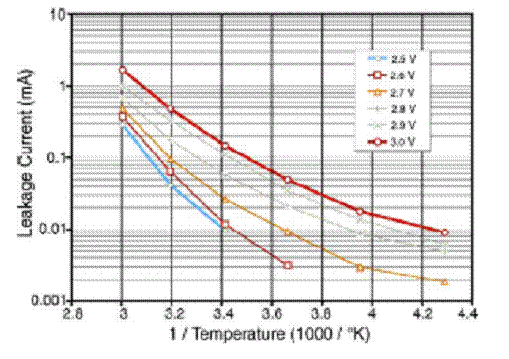
Arrhenius plot of the leakage currents at various capacitor voltages and temperatures measured after 10 h of constant conditions. At each voltage, the temperature of the EDLC was first held 100 h at 60 C before the temperature was decreased in steps of 20 C down to −40 C.
The plots do not exhibit straight lines. Only reasonable estimations for the activation energies and acceleration factors are possible. For the temperature range between 0 C and 60 C, an average activation energy of −0.57 eV (54 kJ mol−1) was determined, while in the temperature range 0 C and −40 C, the effective activation energy was only − 0.22 eV (21 kJ mol − 1). These activation energies are lower than the 0.8 eV usually assigned for Aluminum electrolytic capacitors.